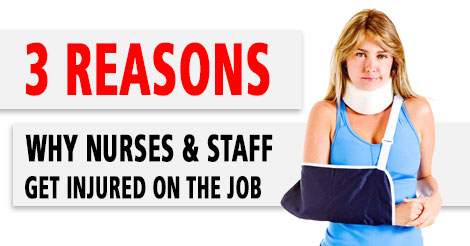The nursing profession is one of the most dangerous jobs, with a large portion of injuries attributed to interactions and handling of patients. The U.S. Bureau of Labor Statistics (BLS) documented the number of incidents that lead to nurse injury and found the major issues that the healthcare industry should consider minimizing for increased nurse and patient safety.
Here are the top three reasons why nurses get injured on the job, according to the BLS:
- Overexertion and patient handling injuries: 48 percent
The BLS noted that almost half of all injuries that occur among hospital workers stemmed from bodily reaction and overexertion. These injuries were frequently from motions that involved patient handling, including lifting and bending. Nurses who have inadequate or lack of access to patient handling tools are at risk for musculoskeletal injuries that result in days away from work.
Nurses who perform repetitive motions and other patient handling tasks could benefit from proper instruments for supporting and lifting patients, such as high-quality slide sheets, like the Swift Slider & UltraSlide bottom sheet. These tools are designed to reduce friction when transporting patients and lower the risk of sprains and strains that occur in a healthcare setting.
- Slips, trips and falls: 25 percent
Other big workplace hazards that cause nurses to take time off work are falls, slips and trips, accounting for 25 percent of hospital worker injuries. Data from the National Council on Compensation Insurance (NCCI) cited in a U.S. Occupational Safety and Health Administration (OSHA) report showed 17 percent of hospital workers’ compensation claims were from these types of injuries, leading to 25 percent of lost time.
Fall- and trip-related injuries also have a connection to the risks of patient handling, especially as healthcare workers age. OSHA highlighted the issue that as healthcare staff age into their 40s and 50s and their bones start to become weaker, the chances of experiencing fractures or trauma from patient handling or falls are heightened. This, combined with higher numbers of obese patients, that make transporting and moving patients more difficult, have become greater workplace safety issues now more than ever.
- Contact-related incidents: 13 percent
Finally, the BLS found 13 percent of hospital and nurse injury were from contact with objects. These can include contact with equipment and instruments, such as needlesticks.
To avoid needlestick and sharps-related incidents, managers must ensure hospital workers are trained in universal precautions during injections, suturing or operating to lower the exposure risk of bloodborne pathogens and communicable diseases. In addition, training in the correct decontamination and disposal of needles and the use of safer devices like needleless systems for IVs can also result in declines in needlestick injuries.
With the high risk of injuries in hospitals and other healthcare environments, nurses should look into safer alternatives that are more ergonomic, reduce the risk of slips and falls, and avoid occupational exposure to illnesses and diseases.
To find out more on how the Swift Ultraslide System can help reduce nurse injury from patient handling and lifting, contact your local MIP Inc. Representative, or visit their website.





.png)


